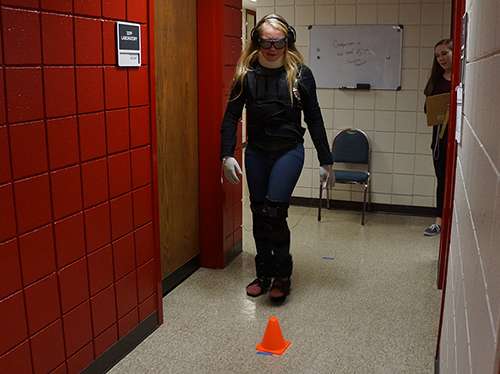Research looks at prevalence of ageist attitudes toward older adults

Strap on flat-footed "shoes" first, followed by ankle weights and knee braces. Then, add elbow braces and a vest weighted with 20 pounds. Put on gloves and attach a TENS unit—which stands for transcutaneous electrical nerve stimulation and issues mild, safe electrical signals—making your hands feel prickly like they are going numb. Moving on up the body, fasten on a neck brace, put in ear plugs covered by headphones and, finally, put on goggles.
This "aging suit" simulates weight gain, arthritis, poor posture, diseases such as Parkinson's or medication that cause trembling, decreased circulation, decreased spinal flexibility, impaired hearing and cataracts—all conditions that may be common as people age.
The young woman, an undergraduate student, who wore all of this garb said the effect was definitely uncomfortable, although not painful during the short time she wore it while another undergraduate collected data. In about an hour's time, she took two surveys at the beginning and end of the session, performed flexibility, strength and gait-speed tests and took a six-minute walk on the indoor track at the Health, Physical Education and Recreation building on the University of Arkansas campus.
Ashley Binns, a U of A doctoral student in exercise science, is coordinating the research project studying ageism under the supervision of her adviser, Michelle Gray, an associate professor of exercise science in the College of Education and Health Professions.
The project funded by the Teaching and Faculty Support Center at the U of A uses three methods to assess perceptions people have of older adults and whether those perceptions can be changed. One group of study participants puts on the aging suit and goes through a battery of activities to gauge fitness. A second group takes part in a service-learning project at an assisted living facility serving older adults. A third group learns about aging in a traditional classroom setting.
Each group takes two surveys before and after the activity. One survey gives a series of statements about older adults and asks the participant to say whether the statement is true or false. Some examples: "The majority (more than half) of old people (age 65 or older) are senile (i.e., defective memory, disoriented, or demented, etc.)," "Aged drivers (age 65 or older) have fewer accidents per driver than drivers under the age 65," and "The majority of older people (age 65 or older) say they are seldom angry."
The other survey lists a series of polar-opposite adjectives and asks the participant to rate their impressions of older adults on each line. Some of the word pairings are cheerful and crabby, humble and arrogant, frugal and generous, and safe and dangerous. They are told to think about older adults in general, not family members such as grandparents.
The majority of participants so far have been undergraduate students in exercise science but the researchers are recruiting people up to the age of 59 so that they can compare results across decades. An online form is available for people interested in participating in the ageism study and other research being conducted in the Human Performance Laboratory.
There were 40 million American adults over 65 years old in 2010 and the number is projected to grow to 90 million by 2050, Gray said.
"That is an astronomical increase," she said. "An important aspect of our research is looking at the question of how we can decrease ageism among our students and in society. Ageism affects more people than racism and sexism. How can we change people's attitudes?"
Binns and Gray said discrimination against older adults is common, particularly in employment situations.
"Companies either don't hire the older applicant or they make less money," Gray said.
Binns said some older adults hide signs of aging in order to be more competitive in the job market. She met one person who needed to have hearing aids but didn't get them because he felt it would hurt his chances of getting a job.
"When we ask students the first word that comes to their minds about older adults, 99 times out of 100 the answer is negative," Gray said. "The only positive response has been 'wisdom.' Some of the answers could be considered innocuous like wrinkles or gray hair."
Very little research has been done on ageism, she said, and use of the aging suit has not yet been validated as a research tool. The aging suit was suggested by Melissa Powers, a U of A graduate who teaches at the University of Central Oklahoma and who collaborated with Gray when both were doctoral students in Fayetteville.
"The manufacturer says the suit ages you 30 to 40 years, but is that true?" Gray asked. "We know that performance on the fitness tests goes down after putting it on. Does it age you while performing these physical tasks? The preliminary answer is yes."
Gray described the research project as a first wave. Next, she would like her students to study ways to translate changing attitudes toward older adults into changing behavior toward them.
Binns will compete in the President's Cup at the national meeting of the American College of Sports Medicine next spring after winning a regional competition with the research project.

















